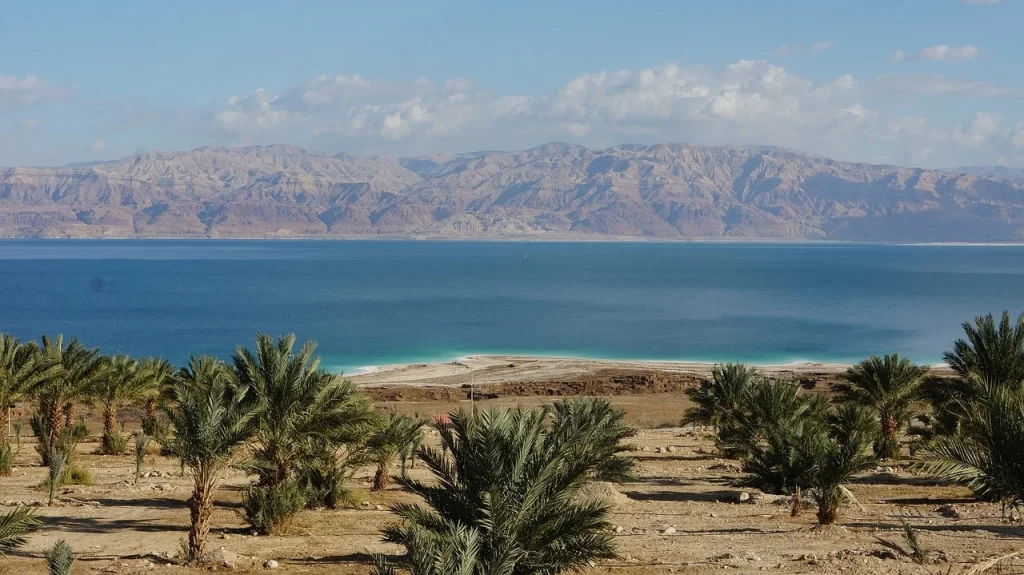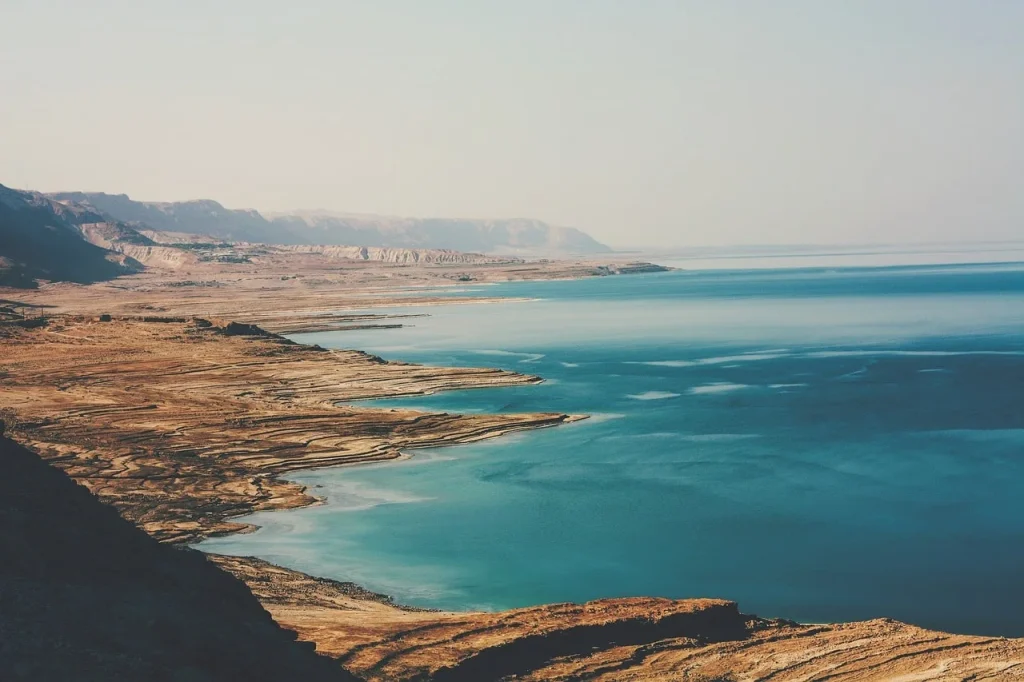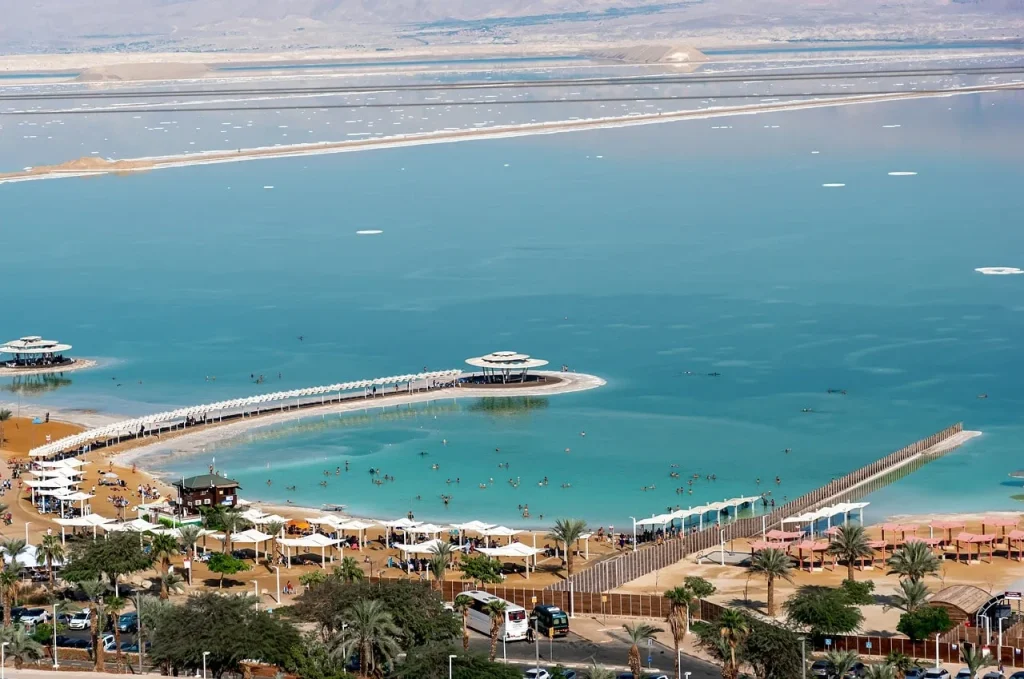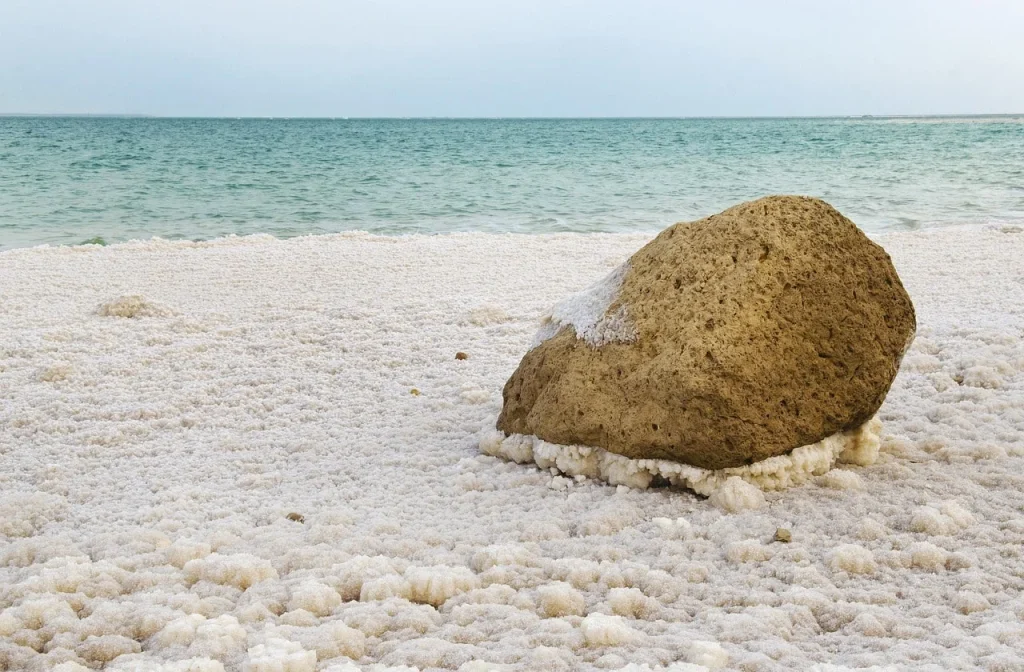Imagine floating effortlessly in a sea where no life can thrive. The Dead Sea, a salt lake bordered by Jordan to the east and Israel and Palestine to the west, is a natural wonder unlike any other.
Known for its extreme saltiness and rich historical tapestry, this body of water offers more than just unique swimming experiences.
Join me as we explore some interesting facts that reveal the depth of beauty and intrigue hidden in the waters of the Dead Sea.
The Dead Sea is a living example of paradox.
Isaac Bashevis Singer
Dead Sea Facts
Before we explore the facts, prepare yourself for a challenge. Read attentively; a quiz at the end of the article will test your mastery of the topic.
- This body of water has a salinity of around 34%, making it nearly ten times saltier than the ocean.
- Microorganisms called halophiles thrive in its harsh conditions, despite the high salt content.
- The unique buoyancy caused by the salt allows people to float effortlessly on the surface.
- It is one of the world’s saltiest bodies of water and is inhospitable to most aquatic life forms.
- The mineral-rich mud found here is famous for its therapeutic properties and is used in many skincare products.
- It is receding at an alarming rate of more than one meter per year due to water diversion from the River Jordan and mineral extraction.
- Its surface and shores are 423 meters below sea level, making it the Earth’s lowest elevation on land.
- The climate around the area is typically dry and sunny, with low humidity year-round.
- Historically, it was a refuge for King David and a place of exile for Herod the Great.
- The surrounding region is considered a place of biblical significance, referred to in texts concerning Solomon and Abraham.
- The ancient Egyptians used asphalt harvested from this sea for mummification.
- The water’s hypersalinity prevents boats from operating properly, making it impossible for traditional maritime activities.
- Potash, used in fertilizers, is one of the many minerals commercially harvested from the area.

- Due to the extreme environment, fish accidentally swept into this sea by floods quickly die.
- The unique atmospheric conditions allow for the easier inhalation of oxygen, benefiting people with respiratory issues.
- The name in Hebrew, “Yam Hamelach,” translates to the Sea of Salt.
- Despite its name, it is actually a lake, with the Jordan River being its main tributary.
- The waters hold a rich concentration of potassium, magnesium, and bromide, which are believed to offer health benefits.
- It is shrinking, causing sinkholes to form along its shores, which can be hazardous to developments.
- Its location is tectonically active, situated within the Jordan Rift Valley.
- The Dead Sea Scrolls, some of the oldest known biblical manuscripts, were discovered in nearby caves between 1947 and 1956.
- Temperatures in the area can soar to over 40 degrees Celsius (104 degrees Fahrenheit) in the summer.
- The hypersaline water creates a harsh environment where rainfall is exceedingly rare.
- The unique evaporation process of the sea contributes to the dense, mineral-rich mud that is exported globally for cosmetic treatments.
- The surrounding desert landscape contrasts sharply with the vibrant turquoise of the water.
- Historically, it has been a major trade route for goods like spices and fabrics between the East and West.
- It is estimated that if it continues to recede at the current rate, it could be reduced to a series of smaller pools.
- Its high mineral content provides a natural filter for harmful UV rays, reducing sunburn risks.

- The sea’s mineral products have been marketed worldwide as natural health and beauty remedies.
- Over 1.7 million tourists visit annually, drawn by the healing properties and historical significance.
- The low elevation creates one of the world’s most unique climates, resulting in high barometric pressure.
- Many endangered species of animals and plants find refuge in its unique microclimate and geological features.
- The sea’s mud is often used in therapeutic baths and facials at luxury spas around the globe.
- It has been a site for health research due to the healing properties attributed to its environment.
- The combination of bromine and magnesium in the air is thought to have calming effects on the nervous system.
- During the winter, the surrounding area sometimes experiences flash floods, which add fresh water but quickly evaporate.
- Its minerals are extracted through a process that uses solar evaporation ponds.
- Cleopatra of Egypt is said to have valued the sea for its beauty-enhancing properties.

- The lack of humidity around the sea allows for exceptional preservation of materials, including textiles and scrolls.
- Flora in the area is sparse, consisting primarily of salt-tolerant plants like halophytes.
- The darkness and density of the water create a serene and otherworldly swimming experience.
- Explorations and studies continue to uncover new aspects of its unique ecology and geological features.
- The landlocked nature contributes to its high salinity, as minerals accumulate without any outlets.
- It has been a popular location for artistic and commercial photography due to its stark and dramatic landscape.
- Several health resorts around the sea offer treatments for skin diseases, respiratory issues, and rheumatic conditions.
- The water’s high density makes submerging difficult, leading to a sensation of floating on air.
- Major fluctuations in water levels have revealed previously submerged structures and archaeological artifacts.
- The area is a significant bird migration route, hosting hundreds of species on their journey between Africa and Northern Europe.
- Peat layers found beneath the sea contain records of climate change over thousands of years.
- The air’s increased oxygen levels can enhance physical performance and recovery for athletes training at this location.
Dead Sea Myths

Now that you’ve learned some fascinating facts, let’s explore the myths. We’ll separate truth from fiction and discover what’s real.
- The Dead Sea is the saltiest body of water in the world.
While it is extremely salty, it is not the saltiest body of water on Earth. Donner Lake in Antarctica holds this distinction, with salinity levels that can exceed those of the Dead Sea. - No life can be found in the Dead Sea.
It is commonly believed that it supports no life forms. However, microbial life such as bacteria and fungi are indeed found in its waters, demonstrating an adaptation to extreme salinity. - The Dead Sea has always been at its current size.
Over the centuries, the size and shape of the Dead Sea have changed significantly. Its water levels have been lowered mainly due to water diversion from the Jordan River and mineral extraction activities. - The waters of the Dead Sea have no health benefits.
Contrary to this belief, the mineral-rich waters and mud of the Dead Sea are renowned for their therapeutic qualities. Skin conditions and joint pains are often effectively treated by these natural resources. - Swimming in the Dead Sea is just like swimming in any other sea.
Swimming in the Dead Sea is unique due to its high buoyancy caused by the elevated salt content. This unusual condition means that floating is made much easier, and traditional swimming is quite challenging.
Dead Sea FAQ

As we move on, we are getting closer to the quiz. But before that, let’s carefully read the questions in the FAQ section.
- How deep is the Dead Sea?
It is quite deep, with the deepest point being about 304 meters (997 feet). It’s one of the deepest hypersaline lakes in the world. - Why is the Dead Sea so salty?
It is extremely salty because it has no outlet. Water flows into the lake from rivers and streams but can only escape by evaporation, leaving behind salts and minerals. This process has concentrated the salt content over thousands of years. - Are the Dead Sea Scrolls real?
Yes, the Dead Sea Scrolls are indeed real. They consist of thousands of ancient texts discovered in the mid-20th century near the Dead Sea. These texts include biblical manuscripts, sectarian writings, and other documents that have provided valuable insights into the history and culture of ancient Judea. - Why is the Dead Sea called the Dead Sea?
It is called “dead” because its high salinity prevents most aquatic life forms, such as fish and plants, from thriving in its waters. The harsh environment means that few organisms can survive, giving the sea its name. - How was the Dead Sea formed?
It was formed millions of years ago due to the movement of tectonic plates. This movement created the Jordan Rift Valley and allowed the land to sink, forming a natural basin that was filled by waters from surrounding rivers. Over time, as these waters evaporated, they left behind the highly saline body of water known as the Dead Sea.
Dead Sea Trivia

Ready to test your Dead Sea knowledge? Beware, getting zero right means you’ll be sentenced to an imaginary swim with only salty facts for company!
Conclusion
To sum up our journey through the mysteries of the Dead Sea, this remarkable salt lake is more than just a spot on the map—it’s a natural wonder that offers healing, history, and unique experiences.
From its therapeutic mud to its ability to make people float effortlessly, the Dead Sea is a destination that continues to captivate and amuse. It reminds us of the incredible power and beauty of nature, urging us to take care of such irreplaceable treasures. Till next time, stay curious and explore more. Cheers.
6 Sources Used For This ArticleSaltiest Body Of Water On Earth – Study Country
The Dead Sea – Geology Science
Questions & Answers about the Dead Sea – Dr Mud Dead Sea
Dead Sea – Religion Fandom
Dead Sea, Israel – Triping To Israel


